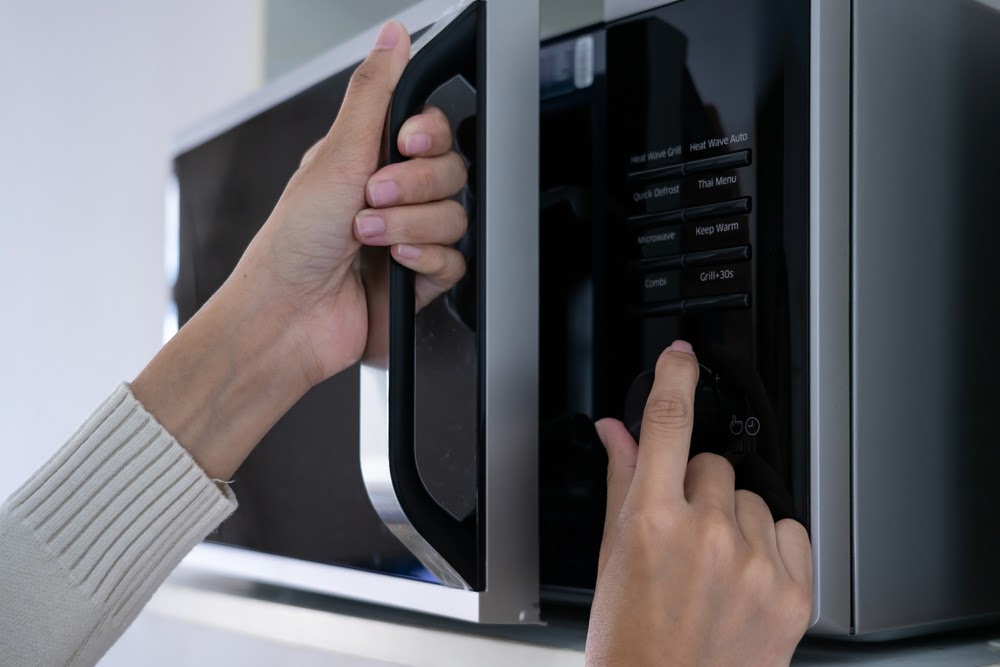Does an Energy-Efficient Microwave Save Money?
There are some appliances that suck up serious energy each month. Heating and cooling (aka HVAC), the water heater and the washer and dryer all account for almost three-quarters of the energy use of the home. In fact, the air conditioner and furnace use almost half of the energy use of the home.
After these three main energy vampires, lighting zaps about 12 percent of the household energy. When homeowners want to cut costs, they may opt to upgrade to energy-efficient models of these top energy drains. But what about other smaller appliances like the microwave? Does an energy efficient microwave save money? Here’s what homeowners need to know.

How Much Energy Does a Microwave Use?
Homeowners who have a standard (i.e. non energy-efficient) microwave in their home might be curious how much electricity it uses. According to Arcadia, the microwave only uses about $13.46 of electricity per year. Arcadia based this on homeowners using the microwave for around 15 to 30 minutes every day.
Compared to other appliances, the microwave isn’t a huge energy drain. Homeowners might spend a little more than a dollar to use their microwave each month. So how much can an energy-efficient microwave actually save?
When looking at the ENERGY STAR site, it is noted that there currently are no microwaves that bear the label. Homeowners could find, though, microwaves that double as a convection oven. These models could save money related to not using the larger oven.
Here’s where costs and energy get a bit complicated, though. Many people might assume that the microwave is the more energy-efficient choice when compared to an oven. However, a story on KQED explained this isn’t always true, as the cost of gas could be cheaper…therefore making a standard oven the energy winner. Or, at least, the cheapest option.
Energy-Efficient Cooking
When comparing an electric microwave with an electric range/oven, though, the microwave is the winner. While microwaves don’t currently have an ENERGY STAR label, homeowners might use them in place of the oven when applicable.
For example, heating up some pizza is probably quicker and more energy-efficient via the microwave. Using the oven might just be a time waste…and an energy drain. Although maybe it delivers crunchier pizza!
Want to save money on that microwave, though? Pull the plug! Like a coffee maker, the microwave usually displays the time. This uses energy. If you aren’t using that small oven, just unplug it and stop wasting energy. Homeowners may save a little cash by doing this.

Saving Energy and Money
While homeowners might not be in luck regarding an energy-efficient microwave option, there are many ways they can take control of their energy use and misuse. The microwave is using energy as long as it’s plugged into an outlet, and, again, homeowners can zap that drain by pulling the plug.
The coffee maker and other small appliances also can be pulled, too. If any part of the appliance lights up when it’s plugged in, then it’s using energy. Obviously, homeowners should not unplug any major appliance they use consistently. Just check those outlets for drains.
When homeowners can use the microwave for cooking, this could be the cheaper and more energy-efficient choice when compared to a standard oven. However, the cost of gas could be cheaper. So, again, savings could be better by opting for gas over the electric-powered microwave.
Remember that the major drains of the home are the HVAC, the hot water heater and the washer/dryer. When these appliances are up for replacement, homeowners might consider upgrading to more energy-efficient options.
In the meantime, homeowners can make a few changes to decrease their energy use and their cost. During the summer, turn up the thermostat to around 78 degrees Fahrenheit (maybe even warmer when no one is home). This keeps the air conditioner from kicking on more frequently. During the winter, keep the thermostat lower (around 68 degrees Fahrenheit). Even small temperature changes could make an impact. Heating and cooling accounts for nearly half of the energy use of the home, and this might be the area to focus energy-efficiency.
Lights also drain electricity. While most homeowners have likely switched to LED bulbs, leaving lights on when they aren’t in use just wastes energy. Make it a habit to turn off lights when leaving a room.
When washing clothes, only wash full loads of clothing. Smaller loads may lead to washing more loads…and more instances of using the machine. Remove clothes from the dryer once they are dry. Forgetting those clothes means recycling the load to dry yet again, which bumps up the cost.
While microwaves might not bear the ENERGY STAR label, they might save homeowners energy when used wisely. Microwaves aren’t a huge energy drain, and they may be a better choice than using a standard oven. However, the cost of gas (if the oven uses gas) also could mean that the oven is the cheaper option. Saving money with a microwave also means unplugging it when it’s not in use. Homeowners also can make other changes around the home to lower their monthly energy bill and decrease their energy waste.


